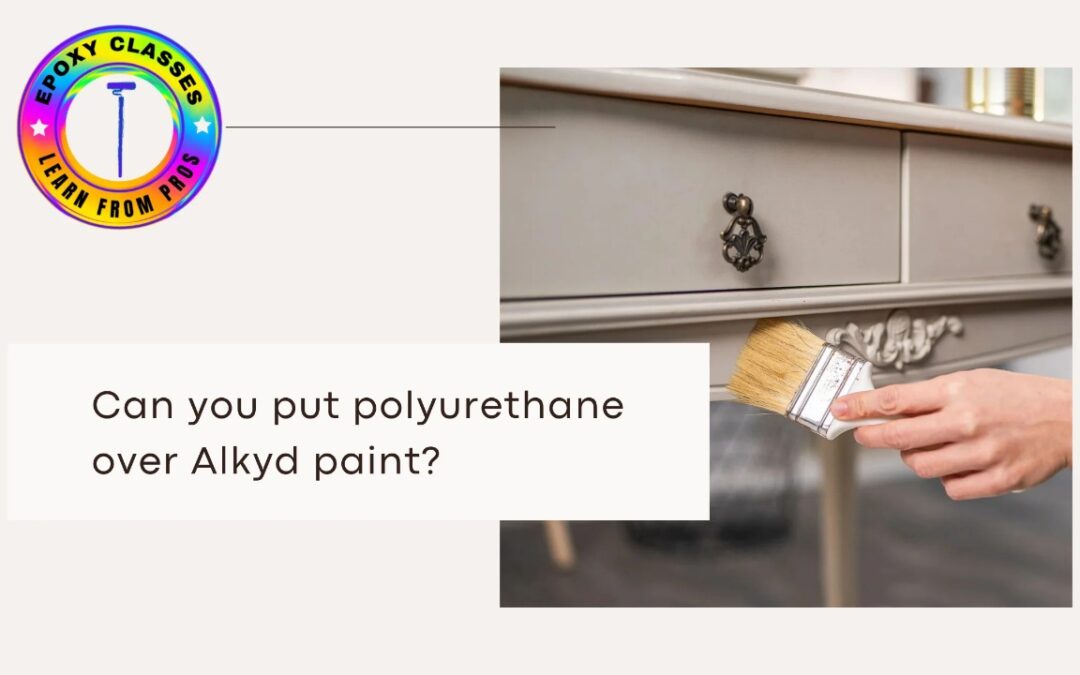Can You Put Polyurethane Over Alkyd Paint? A Quick Guide!
Wondering if you can apply polyurethane over alkyd paint for a durable, glossy finish? It’s one of the questions we commonly hear from both DIY enthusiasts as well as professionals. Whether you are refinishing a furniture or improving epoxy floor, knowing how these coatings interact is essential to get a classic, flawless result.
At Epoxy Classes NY, we are all about guiding and teaching the art of long lasting, durable surfaces. Here’s a quick guide for you, let’s break down the information, analyze the steps, and exchange advice from experts to help you make your project stand out.
Alkyd Paint and Polyurethane: Learn The Basics
Let’s start with knowing what Alkyd paint and polyurethane is. Alkyd paint is an oil based paint that works best for high traffic areas like trim or furniture. It provides a durable and glossy finish. On the other hand, polyurethane works as a protective topcoat that adds toughness to the surface, helping it stand against scratches and water.
Another common question asked is, can you put polyurethane over alkyd paint? A short answer? Yes, but it requires proper preparation, it’s a great way to increase the durability and shine.
Why Use Polyurethane Over Alkyd Paint?
Applying polyurethane over alkyd paint can upgrade and enhance your project by:
- Extra Protection: Polyurethane provides a hard, protective layer that works as a shield against scratches, water, and UV damage.
- Enhanced Look: It gives a polished look to the painted surface by adding glossy or stain sheen.
- Longevity: Polyurethane protects against damage, increasing the life of your painted surface.
This combination is commonly used, especially for decorative pieces and painted furniture in homes and offices.
How to Apply Polyurethane Over Alkyd Paint
- Let it Cure: Alkyd paint needs to be cured completely. It takes 24 to 48 hours, or even longer to be fully dry. The curing time depends on the product type and condition. Always check the manufacturer’s instructions before using it.
- Clean Surface: A clean surface is important for better adhesion. Use a mild cleaner and a soft cloth to wipe dust or grease.
- Lightly Sand: Go for a fine grit sandpaper (220-320 grit) to brush the surface. Sanding creates a texture that helps polyurethane to stick properly.
- Choose Polyurethane: Go for water based polyurethane for a clear finish, and oil based for durability, though it may get slightly yellowish. Test compatibility on a small area first.
- Apply Thin Coats: Apply thin layers and let each layer dry for at least 4-6 hours, longer for oil based polyurethane.
- Sand Between Coats: Use 400-grit sandpaper for a smooth finish, cleaning dust each time.
Want to improve your coating skills? Join our epoxy classes for professional training and hands-on experience!
Things to Avoid
- Skipping Sanding: Without proper sanding, polyurethane may peel or bubble. Always sand the alkyd paint surface to improve smoothness and adhesion.
- Incompatible Products: You may face adhesion issues if oil-based polyurethane is used over water-based alkyd or vice versa. Always check the product labeling or test a small area first.
- Yellowing: Oil-based polyurethane may cause the surface to gradually turn yellowish or off-white. Use water-based for bright, white surfaces.
Applying polyurethane over alkyd paint can be challenging. Our epoxy training provides the right skills you need to create flawless results. Join epoxy flooring classes or reserve your spot. Contact us for details and start your coating journey today!
Frequently Asked Questions
Can you apply polyurethane over alkyd paint without sanding?
No, sanding between coats is important for adhesion and preventing peeling.
Does polyurethane change alkyd paint’s color?
Water-based polyurethane stays clear; oil-based may add a slight yellow tint.
How long should alkyd paint dry before polyurethane?
Wait 24-48 hours for alkyd to dry and cure fully. It may take longer depending on the type of product being used.
